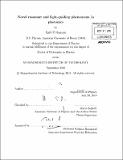Novel resonant and light-guiding phenomena in photonics
Author(s)
Hamam, Rafif E. (Rafif Ezzat)
DownloadFull printable version (10.02Mb)
Other Contributors
Massachusetts Institute of Technology. Dept. of Physics.
Advisor
Marin Soljačić.
Terms of use
Metadata
Show full item recordAbstract
We investigate theoretically five novel resonant and light-guiding photonics phenomena. First, we develop a universal coupled mode theory (CMT) treatment of the freespace scattering of waves from resonant objects. This analytical framework very accurately models the scattering and absorption cross sections, as long as the resonant scatterer has spherical/cylindrical symmetry, or is sufficiently smaller than the resonant wavelength of the incident wave. We apply it to study the scattering of light from spherically symmetrical resonant objects and atoms, and also the neutron scattering off nuclei. Then, we propose an efficient weakly-radiative Wireless Energy Transfer (WET) scheme between two identical classical resonant objects, strongly coupled to an intermediate one having the same resonance frequency. The transfer mechanism, analyzed by CMT, relies on the adiabatic evolution of a dark eigenstate of the 3-object system. We explore its performance in various parameter regimes, and illustrate it by witricity-type WET between resonant inductively-coupled capacitively-loaded metallic loops. Third, we develop an analytical CMT model for the electric field generated by an arbitrary polarization source in a general photonic structure (that could involve loss, gain and/or nonlinearities). Based on this model, we investigate the criteria for enhancing the efficiency of nonlinear effects, and produce efficient terahertz sources. The results, validated by Finite-Difference Time-Domain (FDTD) calculations, suggest that this approach could potentially be a substitute for the more numerically intensive FDTD method. Next, we propose a 2D PhC structure that supports super-collimation over a large frequency range. We theoretically and numerically investigate the collimation mechanism in this 2D structure, in comparison to that of two other frequently used related PhC structures. We also point out the potential importance of this structure in designing super-collimation-based devices for monochromatic and polychromatic light. Finally, we present numerical simulations of anisotropic multilayers that strongly discriminate certain incidence angles of light, over a broad range of frequencies and irrespective of polarization. Such systems could improve the efficiency of solar cells.
Description
Thesis (Ph. D.)--Massachusetts Institute of Technology, Dept. of Physics, 2010. Cataloged from PDF version of thesis. Includes bibliographical references (p. 100-109).
Date issued
2010Department
Massachusetts Institute of Technology. Department of PhysicsPublisher
Massachusetts Institute of Technology
Keywords
Physics.